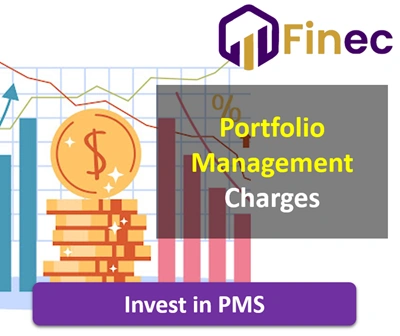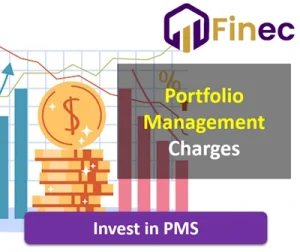High-net-worth and ultra-high-net-worth individuals usually acquire Portfolio Management Services (PMS). Investors must pay certain PMS charges to obtain these services.
Managing investment portfolios is challenging, especially for high-net-worth individuals, so using PMS services has become mandatory.
PMS providers charge investors for offering portfolio management services. These charges can include management fees, performance fees, etc.
Types of Portfolio Management Fees
Portfolio Management Services (PMS) include three types of charges:
- Fixed Charges
- Profit-sharing
- Hybrid Fees
- Brokerage Charges
- Govt. Charges
Each fee structure differs, and PMS providers charge investors based on their portfolios. Here, we have delved in-depth into the types of charges in PMS.
High-net-worth and ultra-high-net-worth individuals often seek the help of portfolio managers.
With diverse investment options, PMS seems like an appropriate solution for managing their investment portfolio.
Moreover, employing PMS services also ensures high returns. Many are confused about PMS’s fee structure, so we created this article to clarify that.
Investors must note that the more diverse the portfolio is, the more charges PMS demands. For investors seeking personalised services, PMS charges higher fees.
Anyway, let us closely examine the types of charges in PMS.
Fixed Charges in PMS
The investor pays a fixed percentage based on portfolio performance in fixed charges. The PMS providers charge a fixed fee ranging from 0.25% to 2.5%, irrespective of the portfolio’s performance.
The costs vary based on the investment approach and are decided based on the average value of investments. Since investors pay these fixed charges annually, they can have peace of mind.
Example of Portfolio Management Fixed Fees
Fixed charges are nothing but management fees. For instance, if you have invested Rs.50 lakh through PMS and your fund manager charges 2% for managing your portfolio, you must pay Rs.1 lakh per year in the name of management fee.
This fee is predetermined and has nothing to do with the performance of your investments.
Related Articles
| Best PMS in India | Top PMS Strategies |
| PMS Investment | What is Portfolio Management? |
| Future of Portfolio Management | Risk Management in PMS |
Profit-Sharing in PMS
As the name suggests, the portfolio manager charges a percentage of the portfolio’s profit. This is similar to an incentive to the fund manager for achieving returns above the threshold limit.
The performance fees are only applied when the return threshold is above the minimum limit. Here, the hurdle rate is considered, which determines the rate of return.
So, if the hurdle rate is 10% and your portfolio makes a 12% return, the performance fee will be 2%.
Example of Performance-based Charges in Portfolio Management
Let’s say you have chosen a profit-sharing model for PMS. If the investment value is Rs.50 lakhs and the hurdle rate is 10%, the fund manager would charge 20% on profits.
If the portfolio performs exceptionally well and earns 10% on the initial investment, the profit will be Rs.10,00,000.
For instance, if the profit exceeds the hurdle rate, the investor must pay 20% of the extra profit earned. So, 10% of Rs.50,00,000 becomes Rs.5,00,000.
The profit above the hurdle rate is Rs.5,00,000. The profit-sharing charges become 20% of Rs.5,00,000, which is Rs.1,00,000.
So, the fund manager would charge Rs.1,00,000 as a profit-sharing fee from the investor.
Hybrid Charges in PMS
As the name suggests, this model requires the investor to pay the fund manager a fixed and performance-based fee.
Investors who want to benefit from both fee structures usually choose this model. The best part about this fee structure is that the fixed cost is lower than the general fixed fee structure.
Example of Portfolio Management Hybrid Fees
In PMS, hybrid charges are a mix of fixed and performance-based fees. For example, say the fixed cost is Rs.50,000 annually, and the performance-based fee is 15% of profits above the hurdle rate of 8%.
If the initial investment is Rs.50,00,000 and the portfolio value becomes Rs.60,00,000 by the end of the year, the profit earned is Rs.10,00,000. With the hurdle rate at 8%, 8% of Rs.50,00,000 is Rs.4,00,000.
Profit above the hurdle rate is Rs.10,00,000. Subtract the hurdle rate from the profit made, which is Rs.6,00,000.
The performance fee is 15% of Rs.6,00,000, which is Rs.90,000. Combining the fixed cost of Rs.50,000 and the performance fee of Rs.90,000, the hybrid fee becomes Rs.1,40,000.
Brokerage Charges in PMS
When the portfolio manager buys or sells stocks or securities on behalf of the client, the broker charges brokerage fees.
Even in PMS, a brokerage fee exists. However, the brokerage charges differ from broker to broker. Some brokers charge a flat fee, and some charge a percentage of the transaction value.
Some Portfolio Management Firms, like Motilal Oswal and 360 One (IIFL), are also stock brokers, so they charge according to their specified brokerage charges.
On the other hand, some PMS firms are not brokers but tie up with brokers.
Delivery Charges
In PMS, delivery charges refer to the charges imposed for holding stocks in the Demat account for a prolonged period.
The delivery charges usually include a percentage of the transaction value, a flat fee, or even zero fees, depending on the broker to broker.
Other Portfolio Management Fees
PMS has a few more essential charges besides the charges we discussed earlier. These include government charges like transaction charges, GST, and Turnover Charges.
Note* – These charges are minimal in number and will never affect your portfolio.
In addition to these fees, the PMS charges minor fees, such as entry load, exit load, and additional charges.
Almost all PMS firms usually charge an entry load of 1% to 3% of the investment value.
PMS Charges – Conclusion
Before proceeding with PMS investments, the investor must understand the fee structure completely. Each fee structure is unique, and one may not suit all investors.
The investor must choose the fee structure based on his risk tolerance. While the fixed fee model is apt for stable investors who like to be at peace after investing, the profit-sharing model is apt for investors who are okay sharing their returns with the fund managers.
On the other hand, investors who don’t want to invest more money into fees can choose a hybrid fee structure.
The best fee structure would be the one that aligns with your financial goals and risk tolerance.






WHAT ABOUT UNDER PERFORMANCE, THE FEES ?